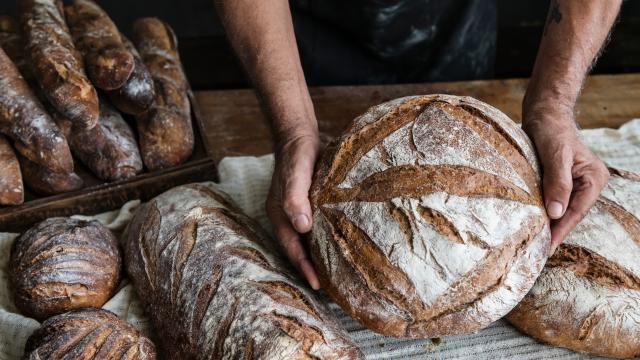You might know sourdough bread as a weird activity during pandemic times, or maybe you’re a long-time bread baker like myself. Sourdough bread is one of the most difficult to make, especially for beginners. Instead of making it the “long way,” you can make a sour-flavored loaf by simply adding vinegar. And, it turns out, adding a bit of vinegar can make for an overall bouncier loaf.
Sourdough is a pain in the ass
Caring for sourdough from wild yeast involves time, patience, and recognizing unusual signs of life in a cup of mush. Mixing and proofing your dough requires an adept eye to assess when it’s ready to bake. Even after these many steps, and possibly four or five days of agonizing over your dough, you can still screw it up, wasting all of that hard work.
I’m not saying, “Why not go out and buy a sourdough loaf?” That’s not a low-effort-bread-baking-trick; that’s just grocery shopping. But it would be nice if there was a shortcut to get sourdough flavor in a loaf instead of nursing a fermented foam for three days before you even begin.
How to fake a sourdough bread
Most of the time when I want something to be sour I add acid to it—and as long as you’re not gifting this loaf to a bread connoisseur, you can do it with bread, too. When baking a single loaf of bread, add a teaspoon and a half up to two teaspoons of white vinegar to the dough mixture. (For this measurement, a single loaf recipe has about 14 to 16 ounces of total flour.) I like to add the vinegar only after the dough has begun mixing. Once it’s a shaggy consistency, sprinkle in the vinegar.
I tried this experiment with a simple lean dough recipe (lean dough is not enriched with butter, eggs, or sugar) for a white bread boule. The first trial had one and a half teaspoons of vinegar added to the mixture. The sourdough flavor was detectable, but I wanted to see if I could get more, so I doubled the vinegar to one tablespoon for the second loaf. The results were fascinating.
How vinegar effects gluten
Bread baking is a practice in observation. It’s such a sensitive science that a change in temperature, ambient humidity, or any seemingly small ingredient change can cause the dough to behave differently. By adding something as powerful as even a diluted acetic acid (white vinegar), I expected a change. I just didn’t know how much it would take to get there.
The answer is: about a tablespoon.
I started noticing changes during the proofing stage. The first proof was about 30 minutes quicker than with the first loaf. During the second proof with shaped dough, I noticed small fissures all around the outside. This was particularly distressing because a taut skin is crucial to a well-formed loaf of bread. This skin allows the loaf to rise upward instead of outward, so you get a nice tall loaf. It also makes it easier to handle as you escort it to the oven. Despite these changes, I rode it out.
The finished second bread had a stronger sour flavor, as expected. It also had an incredibly bouncy, well-risen crumb. My boyfriend and I marveled at the buoyant texture and slightly sour flavor. If the first loaf was good, this one was excellent. However, looks-wise, the loaf was a monster. It had suffered a major blow-out at the bottom, despite my scoring across the top. I’m not an amateur baker, and this isn’t my first loaf. You can see in the pictures below how the first test with less vinegar came out normally, and the second test caused irregularities.


The higher measurement of vinegar had started to break down my gluten network. Besides adding flavor, adding vinegar to dough can act as a helpful dough conditioner, inhibiting the formation of a strong gluten network. This is why adding some to pie crust can keep it from becoming tough. It’s also why the crumb of the finished loaf had extra sponginess and loft to it. However, there’s a limit. Too much vinegar will start to take out gluten indiscriminately—I didn’t get to choose whether the gluten could remain strong on the skin of the loaf. These numerous fissures allowed the bread to rise and tear the dough in an uncontrolled way, instead of through the score I made. To make up for it, the weaker gluten structure in the crust was pleasantly pliable as I ate the ugly slices.
The takeaway
You can fake a sourdough flavor in your average loaf of lean bread, with a caveat. The more vinegar you add, the more structure you lose. That doesn’t mean you can’t add a tablespoon for a strong sour taste. It just means you might need to provide a little support.
My second trial that developed fissures across the entire surface due to the higher vinegar content could have been helped. I was using a peel to slide the boule into my oven and I put gritty cornmeal down to help it launch. Turns out, these itty bitty shards aggravated the situation by poking more holes into my weak gluten crust. Going back, I would have proofed the bread on a piece of parchment paper and baked it in a dutch oven so that no cornmeal would be needed. Better yet, I could bake the bread in a loaf pan for sourdough slices. Overall, I enjoyed the bouncy texture of the crumb and flavorful, pliant crust so much, I can see myself adding a teaspoon of vinegar to future breads, fake sourdough or not.

Leave a Reply
You must be logged in to post a comment.